Testing The World’s Best APUs: Desktop AMD Ryzen 4750G, 4650G and 4350G
by Dr. Ian Cutress on December 16, 2020 10:30 AM ESTCPU Benchmarks: Synthetic
All of our benchmark results can also be found in our benchmark engine, Bench.
Dwarf Fortress 0.44.12: Link
Emulating the ASCII interfaces of old, this title is a rather complex beast, which can generate environments subject to millennia of rule, famous faces, peasants, and key historical figures and events. The further you get into the game, depending on the size of the world, the slower it becomes as it has to simulate more famous people, more world events, and the natural way that humanoid creatures take over an environment. Like some kind of virus.
For our test we’re using DFMark. DFMark is a benchmark built by vorsgren on the Bay12Forums that gives two different modes built on DFHack: world generation and embark. These tests can be configured, but range anywhere from 3 minutes to several hours. After analyzing the test, we ended up going for three different world generation sizes:
- Small, a 65x65 world with 250 years, 10 civilizations and 4 megabeasts
- Medium, a 127x127 world with 550 years, 10 civilizations and 4 megabeasts
- Large, a 257x257 world with 550 years, 40 civilizations and 10 megabeasts
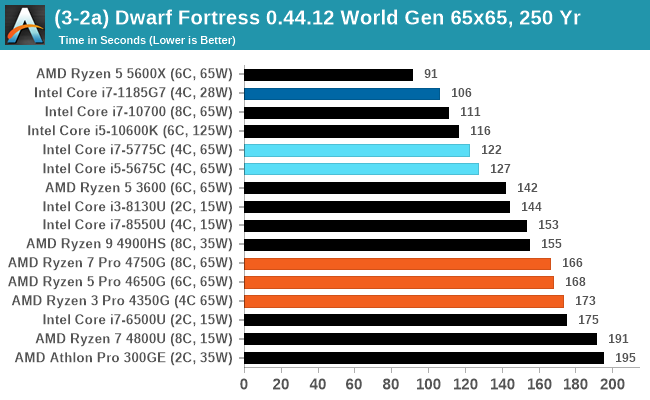
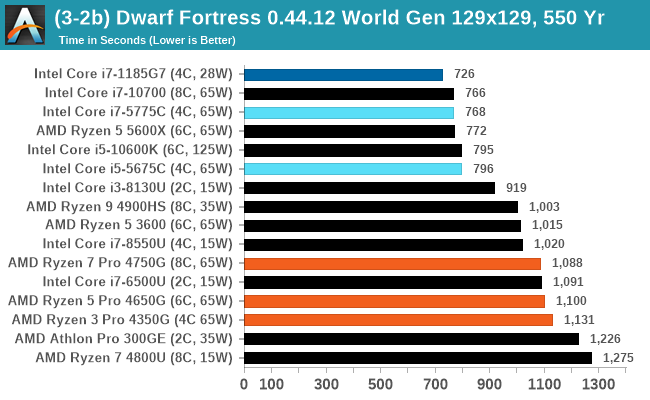
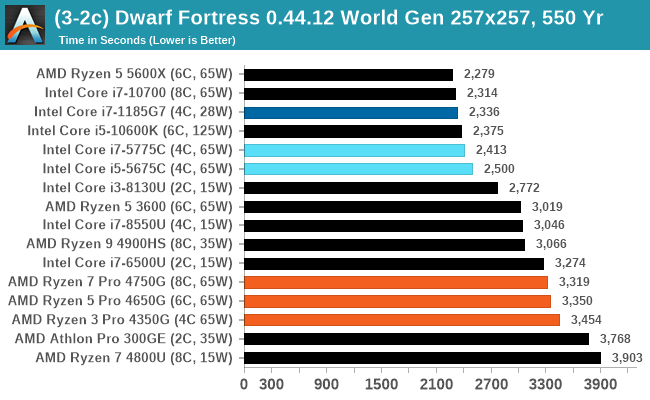
Dolphin v5.0 Emulation: Link
Many emulators are often bound by single thread CPU performance, and general reports tended to suggest that Haswell provided a significant boost to emulator performance. This benchmark runs a Wii program that ray traces a complex 3D scene inside the Dolphin Wii emulator. Performance on this benchmark is a good proxy of the speed of Dolphin CPU emulation, which is an intensive single core task using most aspects of a CPU. Results are given in seconds, where the Wii itself scores 1051 seconds.

3D Particle Movement v2.1: AVX2/AVX512
This is the latest version of this benchmark designed to simulate semi-optimized scientific algorithms taken directly from my doctorate thesis. This involves randomly moving particles in a 3D space using a set of algorithms that define random movement. For v2.1, we also have a fully optimized AVX2/AVX512 version, which uses intrinsics to get the best performance out of the software.
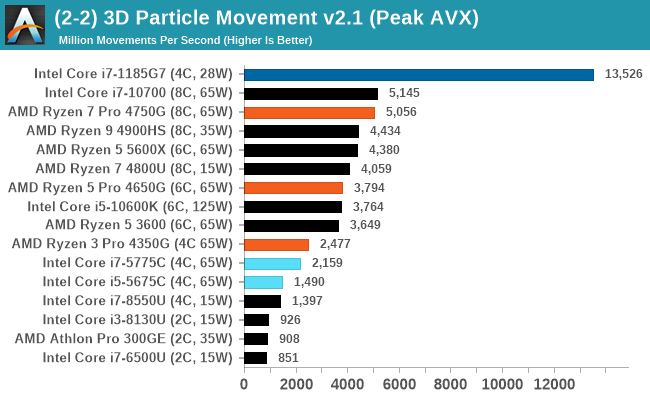
Tiger Lake wins here as it has an AVX512 unit.
y-Cruncher 0.78.9506: www.numberworld.org/y-cruncher
If you ask anyone what sort of computer holds the world record for calculating the most digits of pi, I can guarantee that a good portion of those answers might point to some colossus super computer built into a mountain by a super-villain. Fortunately nothing could be further from the truth – the computer with the record is a quad socket Ivy Bridge server with 300 TB of storage. The software that was run to get that was y-cruncher.
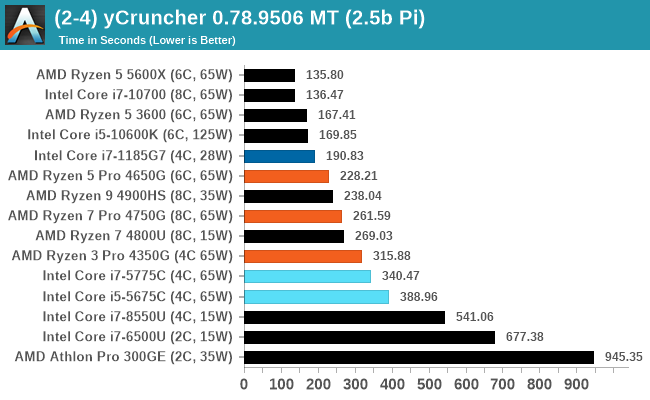
This is another AVX-512 test.
Linux OpenSSL Speed: SHA256
One of our readers reached out in early 2020 and stated that he was interested in looking at OpenSSL hashing rates in Linux. Luckily OpenSSL in Linux has a function called ‘speed’ that allows the user to determine how fast the system is for any given hashing algorithm, as well as signing and verifying messages.
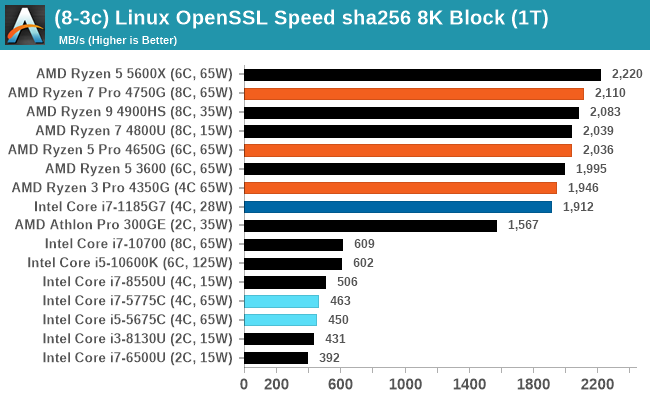
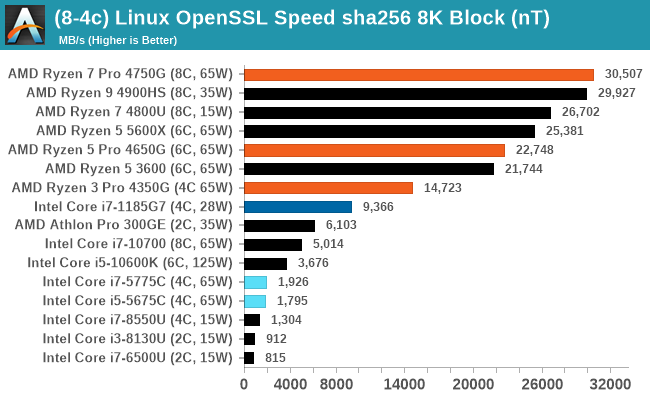










104 Comments
View All Comments
shady28 - Wednesday, December 16, 2020 - link
That's a big deflection. It only includes modern Intel CPUs on the *discrete GPU* tests. Given the title of the article it should have them in the regular iGPU tests. But that wouldn't fit the narrative nor the title now would it? This article needs to be pulled and re-written.Fulljack - Thursday, December 17, 2020 - link
@shady28 that's because Intel Gen 9 and 9.5 iGPU from Skylake and it's derivative are actually worse than Broadwell's Gen 8 iGPU with eDRAM. comparing it would be useless.Flunk - Wednesday, December 16, 2020 - link
If you want to split all the hairs, the M1 is an SoC. The difference being that an APU requires at least one other chip to function, the southbridge (theoretically, how you count "chips" here is somewhat up in the air) and an SoC doesn't.Fataliity - Wednesday, December 16, 2020 - link
Actually, Ryzen on desktop can run without the chipset. The chipset though adds more PCI-E lanes for nvme, etc. So only mITX (I think its an asrock board?) actually might go without the chipset.throAU - Tuesday, December 22, 2020 - link
To be fair, pretty much exactly nobody in the market for an AMD APU based machine is in the market for an M1 based machine at the moment.So whilst they're both processors including integrated graphics, they're totally different market segments.
bananaforscale - Wednesday, December 16, 2020 - link
Can you actually buy an M1 anywhere not soldered onto a Mac mobo? It can't be compared reliably because the platform is completely different, most tests would have to be run through emulation and so on.Frantisek - Sunday, December 20, 2020 - link
Understand and even agree but even in emulation those test would be interesting to see curent state of the art of Apple technology. Most games runs on M1 if not native or Roseta, then PC versions via CodeWeavers. And are playable.Frantisek - Sunday, December 20, 2020 - link
Checked Ex Deus and there is test showing it on M1 in custom 1080p setting with 25-34 fps.TheinsanegamerN - Wednesday, December 16, 2020 - link
No kidding. I mean what about the quallcomm 627 in my phone? Or the VIA chip in my netowrk controller? You cant have a comprehensive review without those!!!!Kuhar - Thursday, December 17, 2020 - link
ricebunny - you are a hoot! :) that`s what you are. ricefunny :)